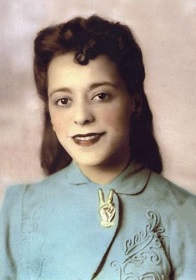
For the week of February 5, 2024.
On February 7, 1965, Viola Desmond died in New York at the age of 50. An iconic figure within the African Nova Scotian community and the Canadian movement for equal rights, she is remembered today as a pioneering Black businesswoman and for her courage in challenging racial segregation in Nova Scotia.
Desmond was born Viola Irene Davis in Halifax in 1914, the daughter of Gwendolyn Irene and James Albert Davis. After graduating from high school, she worked as a teacher in Nova Scotia’s segregated school system before entering the beauty industry working as a hairdresser in her home. Wanting to open her own business focusing African Nova Scotian hair, she left Halifax to train in Atlantic City, New York, and Montréal. In Montréal, she married her long-time boyfriend, Jack Desmond. Returning to Halifax, she opened Vi’s Studio of Beauty Culture in 1946 and later the Desmond School of Beauty Culture. The two businesses provided African Nova Scotian women with rare opportunities to receive professional beauty care and obtain vocational training in the field. Viola Desmond also created and sold her own line of beauty products for Black women under the brand name Sepia.
Desmond was on a business trip in 1946, when her car broke down and she had to spend the night in New Glasgow. She decided to see a movie at the Roseland Theatre, not knowing that it had enforced the racialized segregation of audience members since 1941. Desmond asked for a ticket to the main level but was charged for a less expensive seat in the balcony. When she entered the theatre, the usher directed her upstairs. She returned to the ticket booth and asked again for a ticket for the main level, offering pay the additional ten cents but was told she could not sit in the “whites-only” section of the theatre.
When confronted with racial discrimination, she spontaneously decided to resist. She left money for the more expensive ticket on the counter and returned to the auditorium, taking a seat on the main level. She refused to leave, explaining to the usher that she had tried to pay for the more expensive ticket and was not causing trouble. The manager, Harry MacNeil, called the police. Desmond was roughly carried out of the theatre and taken to the local police station, where she spent the night in jail. Her knee and hip were both injured in the process of her arrest.
Desmond was charged with tax evasion because there was a one-cent difference in the taxes for balcony and main level tickets. During the trial, she was not provided with legal representation or informed that this was her right. In the end, the court ordered her to pay a $ 20 fine and $ 6 in court costs. She lost the court case and a subsequent appeal to the Nova Scotia Supreme Court in 1947.
The local, national, and international press covered the story. Desmond was thrust into the spotlight, her legal case drawing attention to the existence of racial discrimination in Canada and becoming a unifying issue within the growing civil rights movement in Nova Scotia. In the years that followed, she turned down offers to serve in leadership positions within the African Nova Scotian community. She eventually left Nova Scotia for Montréal and then New York.
Viola Desmond was designated a national historic person in 2017. The Historic Sites and Monuments Board of Canada advises the Government of Canada on the commemoration of national historic persons—individuals who have made unique and enduring contributions to the history of Canada.
The National Program of Historical Commemoration relies on the participation of Canadians in the identification of places, events, and persons of national historic significance. Any member of the public can nominate a topic for consideration by the Historic Sites and Monuments Board of Canada. Learn how to participate in this process.